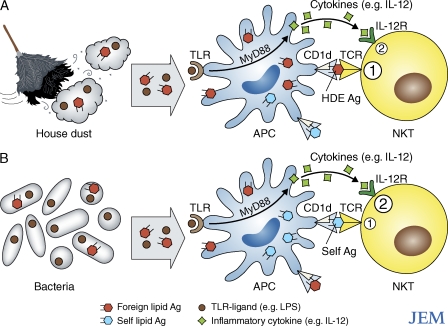Figure 1.
Two pathways of NKT cell activation in response to common environmental stimuli. (A) HDE is essentially ubiquitous, and most samples were found to contain CD1d-restricted Ags (orange hexagons) that are recognized by NKT TCRs (Wingender et al., 2011) and TLR ligands (brown circles; Batzer et al., 2007). Both components are important for the adjuvant effects of HDE (Batzer et al., 2007; Wingender et al., 2011). (B) Some, but not all, bacteria carry CD1d-restricted lipid Ags that are recognized by NKT TCRs, yet NKT cells respond to most bacterial infections. Irrespective of whether a particular strain carries these Ags, the NKT cell response is dominated by innate, TLR, and MyD88-dependent signaling that results in IL-12 (green squares)–mediated stimulation of NKT cells, rather than by bacterial glycolipid Ag recognition (Brigl et al., 2011). The response is also at least partly CD1d dependent, again, irrespective of the presence of bacterial CD1d-restricted lipid Ags, suggesting the recognition of self-lipid Ags in conjunction with the IL-12–mediated stimulation (Brigl et al., 2011). Thus, there are at least two pathways for NKT cell activation: (1) TCR mediated and (2) cytokine mediated. NKT TCR-mediated recognition of foreign lipid-based Ags presented by CD1d that appears to be important for the adjuvant effects of HDE (A), but less so for the response to bacterial infection, whereas innate, inflammatory cytokine–mediated stimulation of NKT cells appears to dominate the response to bacterial infection (B). In the context of bacterial infections, NKT cells may concurrently recognize self- (blue hexagons) or bacterial (orange hexagons) glycolipids, but regardless, the innate (IL-12– and TLR-mediated) stimuli appear to be critical for NKT cell activation.

